A Detailed Report on Enhancing Collaborative Working Practices
VerifiedAdded on 2022/12/19
|6
|1350
|89
Report
AI Summary
This report delves into the significance of collaborative working, defining it as a practice of working jointly to achieve shared goals. It explores strategies for fostering collaboration, including setting specific goals, leveraging team member strengths, and ensuring a trustworthy environment. The report highlights the importance of interpersonal skills like goal setting, time management, and communication. It also discusses the benefits of collaborative working, such as increased creativity, efficiency, and accountability, along with the promotion of equality, diversity, and British values. Furthermore, it examines the consequences of poor collaboration, such as miscommunication and lack of alignment, concluding that engaging employees in collaborative practices is crucial for organizational success. The report references various academic sources to support its findings.

TASK 3 FROM THE BRIEF
ATTACHED
1
ATTACHED
1
Paraphrase This Document
Need a fresh take? Get an instant paraphrase of this document with our AI Paraphraser
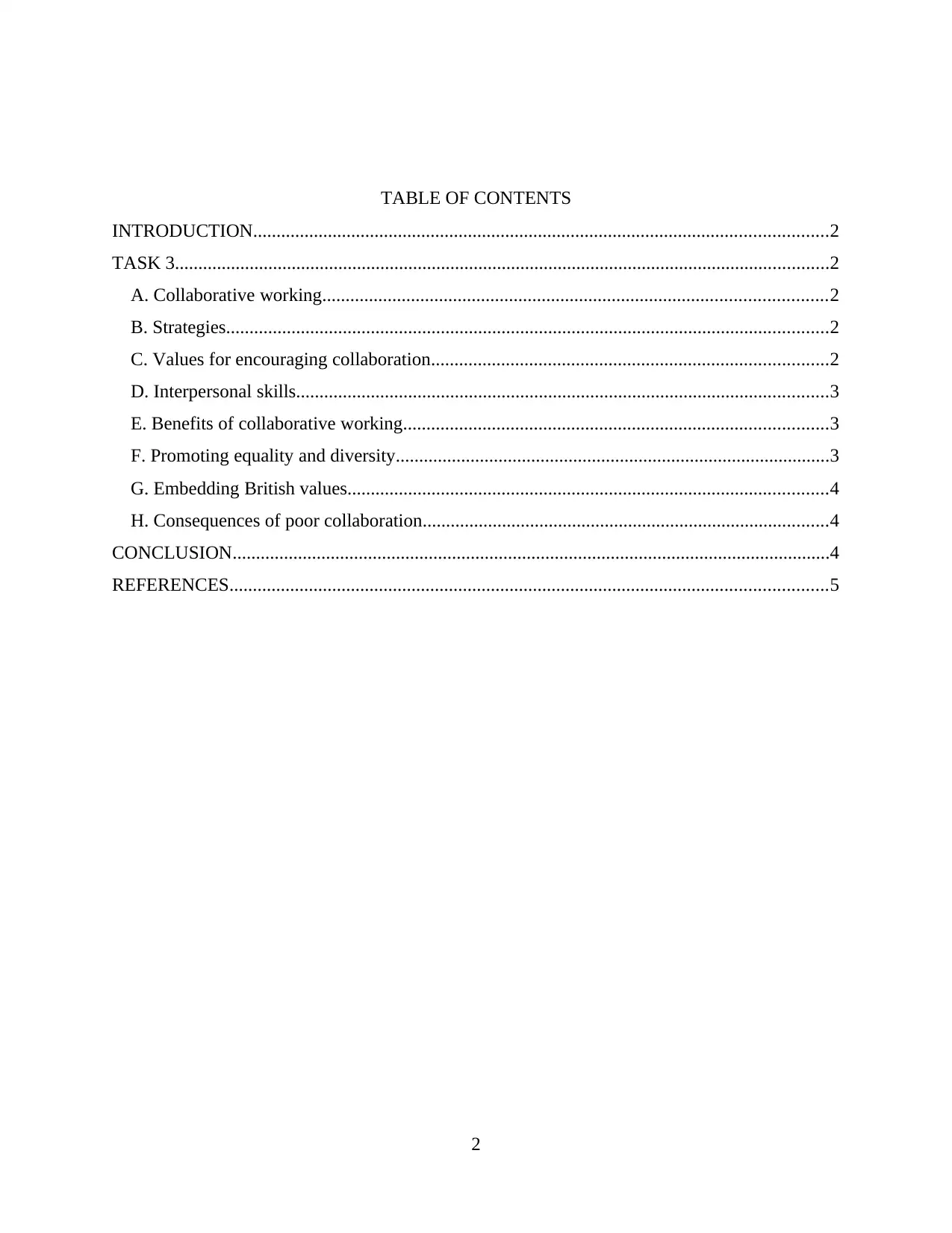
TABLE OF CONTENTS
INTRODUCTION...........................................................................................................................2
TASK 3............................................................................................................................................2
A. Collaborative working............................................................................................................2
B. Strategies.................................................................................................................................2
C. Values for encouraging collaboration.....................................................................................2
D. Interpersonal skills..................................................................................................................3
E. Benefits of collaborative working...........................................................................................3
F. Promoting equality and diversity.............................................................................................3
G. Embedding British values.......................................................................................................4
H. Consequences of poor collaboration.......................................................................................4
CONCLUSION................................................................................................................................4
REFERENCES................................................................................................................................5
2
INTRODUCTION...........................................................................................................................2
TASK 3............................................................................................................................................2
A. Collaborative working............................................................................................................2
B. Strategies.................................................................................................................................2
C. Values for encouraging collaboration.....................................................................................2
D. Interpersonal skills..................................................................................................................3
E. Benefits of collaborative working...........................................................................................3
F. Promoting equality and diversity.............................................................................................3
G. Embedding British values.......................................................................................................4
H. Consequences of poor collaboration.......................................................................................4
CONCLUSION................................................................................................................................4
REFERENCES................................................................................................................................5
2
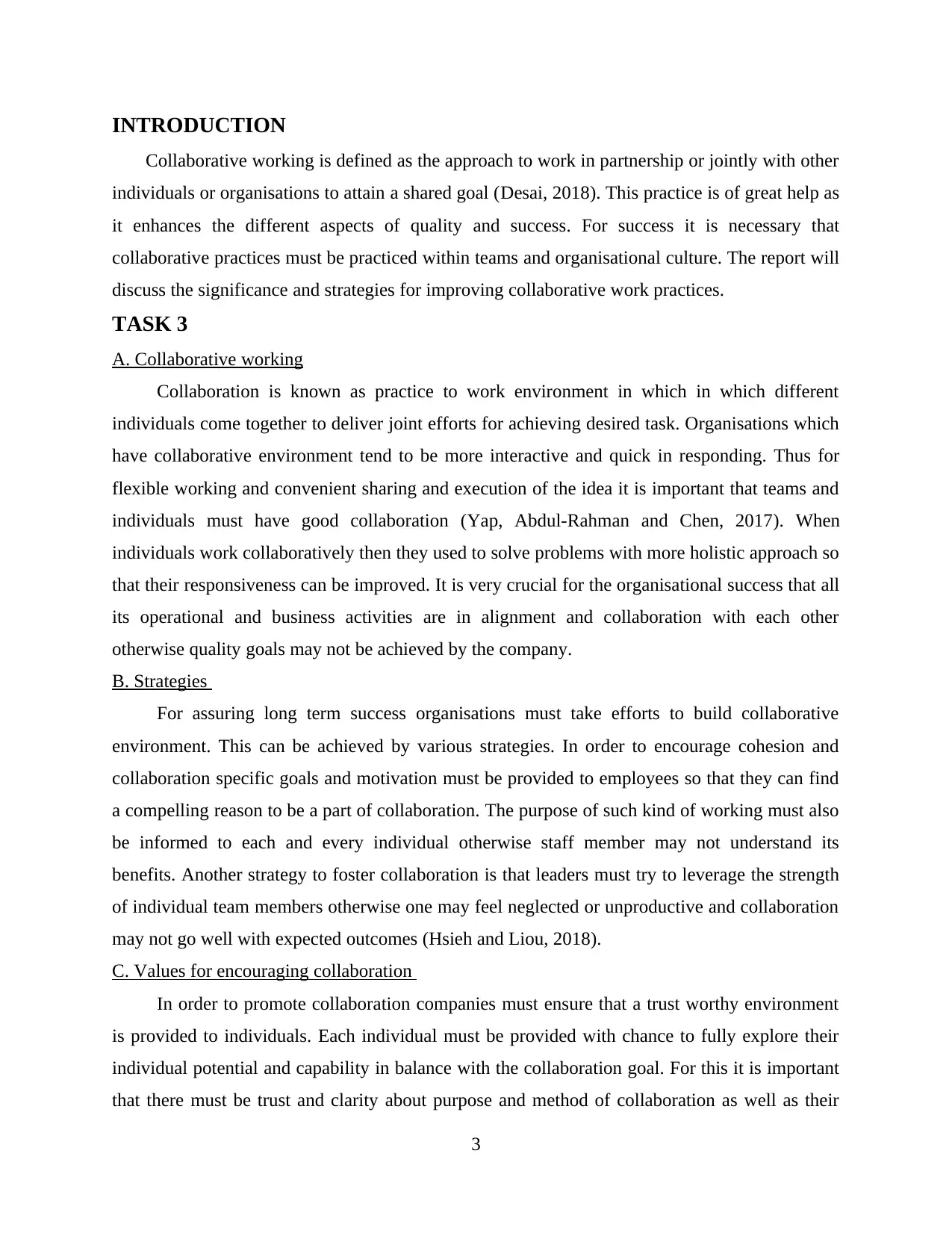
INTRODUCTION
Collaborative working is defined as the approach to work in partnership or jointly with other
individuals or organisations to attain a shared goal (Desai, 2018). This practice is of great help as
it enhances the different aspects of quality and success. For success it is necessary that
collaborative practices must be practiced within teams and organisational culture. The report will
discuss the significance and strategies for improving collaborative work practices.
TASK 3
A. Collaborative working
Collaboration is known as practice to work environment in which in which different
individuals come together to deliver joint efforts for achieving desired task. Organisations which
have collaborative environment tend to be more interactive and quick in responding. Thus for
flexible working and convenient sharing and execution of the idea it is important that teams and
individuals must have good collaboration (Yap, Abdul-Rahman and Chen, 2017). When
individuals work collaboratively then they used to solve problems with more holistic approach so
that their responsiveness can be improved. It is very crucial for the organisational success that all
its operational and business activities are in alignment and collaboration with each other
otherwise quality goals may not be achieved by the company.
B. Strategies
For assuring long term success organisations must take efforts to build collaborative
environment. This can be achieved by various strategies. In order to encourage cohesion and
collaboration specific goals and motivation must be provided to employees so that they can find
a compelling reason to be a part of collaboration. The purpose of such kind of working must also
be informed to each and every individual otherwise staff member may not understand its
benefits. Another strategy to foster collaboration is that leaders must try to leverage the strength
of individual team members otherwise one may feel neglected or unproductive and collaboration
may not go well with expected outcomes (Hsieh and Liou, 2018).
C. Values for encouraging collaboration
In order to promote collaboration companies must ensure that a trust worthy environment
is provided to individuals. Each individual must be provided with chance to fully explore their
individual potential and capability in balance with the collaboration goal. For this it is important
that there must be trust and clarity about purpose and method of collaboration as well as their
3
Collaborative working is defined as the approach to work in partnership or jointly with other
individuals or organisations to attain a shared goal (Desai, 2018). This practice is of great help as
it enhances the different aspects of quality and success. For success it is necessary that
collaborative practices must be practiced within teams and organisational culture. The report will
discuss the significance and strategies for improving collaborative work practices.
TASK 3
A. Collaborative working
Collaboration is known as practice to work environment in which in which different
individuals come together to deliver joint efforts for achieving desired task. Organisations which
have collaborative environment tend to be more interactive and quick in responding. Thus for
flexible working and convenient sharing and execution of the idea it is important that teams and
individuals must have good collaboration (Yap, Abdul-Rahman and Chen, 2017). When
individuals work collaboratively then they used to solve problems with more holistic approach so
that their responsiveness can be improved. It is very crucial for the organisational success that all
its operational and business activities are in alignment and collaboration with each other
otherwise quality goals may not be achieved by the company.
B. Strategies
For assuring long term success organisations must take efforts to build collaborative
environment. This can be achieved by various strategies. In order to encourage cohesion and
collaboration specific goals and motivation must be provided to employees so that they can find
a compelling reason to be a part of collaboration. The purpose of such kind of working must also
be informed to each and every individual otherwise staff member may not understand its
benefits. Another strategy to foster collaboration is that leaders must try to leverage the strength
of individual team members otherwise one may feel neglected or unproductive and collaboration
may not go well with expected outcomes (Hsieh and Liou, 2018).
C. Values for encouraging collaboration
In order to promote collaboration companies must ensure that a trust worthy environment
is provided to individuals. Each individual must be provided with chance to fully explore their
individual potential and capability in balance with the collaboration goal. For this it is important
that there must be trust and clarity about purpose and method of collaboration as well as their
3
⊘ This is a preview!⊘
Do you want full access?
Subscribe today to unlock all pages.

Trusted by 1+ million students worldwide
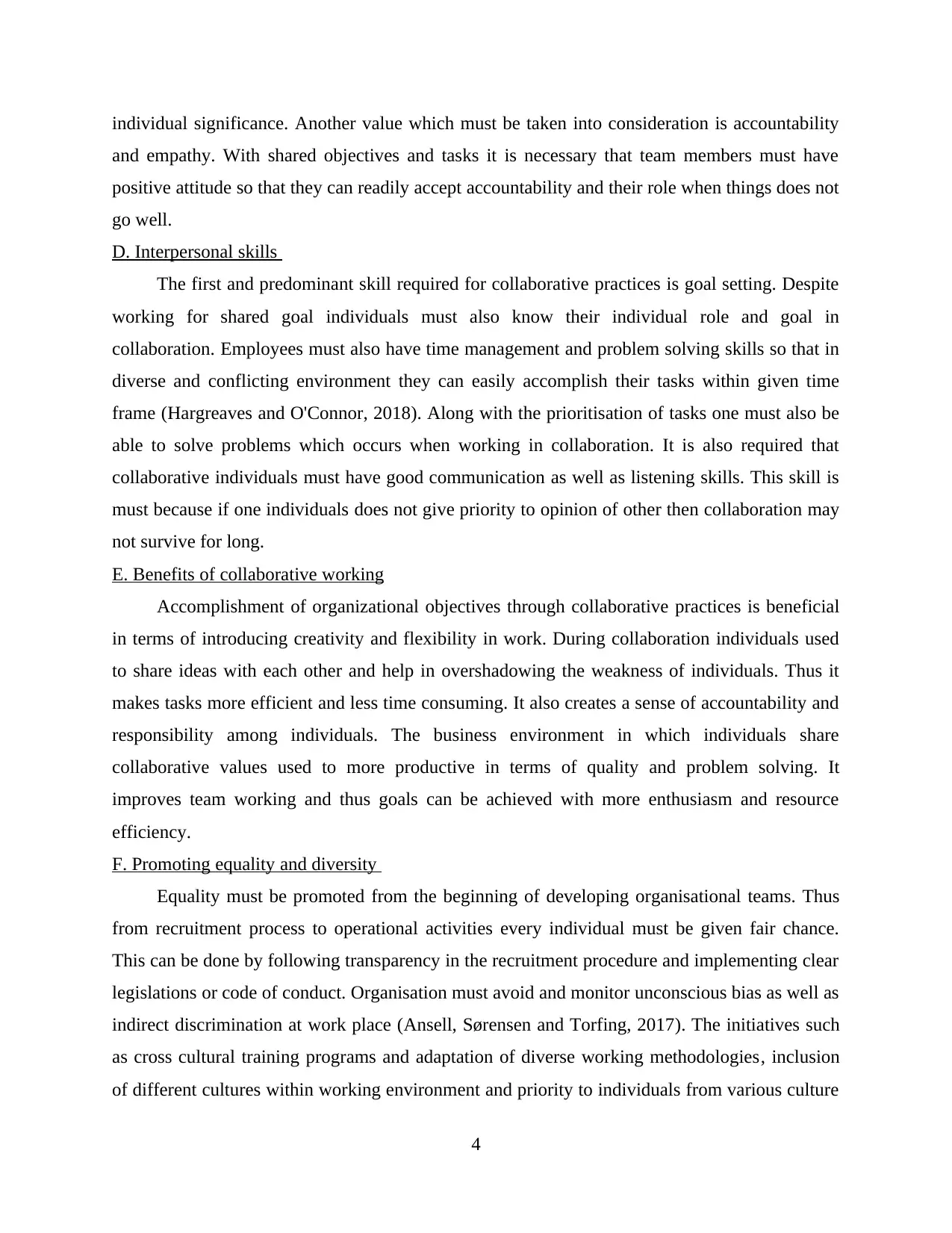
individual significance. Another value which must be taken into consideration is accountability
and empathy. With shared objectives and tasks it is necessary that team members must have
positive attitude so that they can readily accept accountability and their role when things does not
go well.
D. Interpersonal skills
The first and predominant skill required for collaborative practices is goal setting. Despite
working for shared goal individuals must also know their individual role and goal in
collaboration. Employees must also have time management and problem solving skills so that in
diverse and conflicting environment they can easily accomplish their tasks within given time
frame (Hargreaves and O'Connor, 2018). Along with the prioritisation of tasks one must also be
able to solve problems which occurs when working in collaboration. It is also required that
collaborative individuals must have good communication as well as listening skills. This skill is
must because if one individuals does not give priority to opinion of other then collaboration may
not survive for long.
E. Benefits of collaborative working
Accomplishment of organizational objectives through collaborative practices is beneficial
in terms of introducing creativity and flexibility in work. During collaboration individuals used
to share ideas with each other and help in overshadowing the weakness of individuals. Thus it
makes tasks more efficient and less time consuming. It also creates a sense of accountability and
responsibility among individuals. The business environment in which individuals share
collaborative values used to more productive in terms of quality and problem solving. It
improves team working and thus goals can be achieved with more enthusiasm and resource
efficiency.
F. Promoting equality and diversity
Equality must be promoted from the beginning of developing organisational teams. Thus
from recruitment process to operational activities every individual must be given fair chance.
This can be done by following transparency in the recruitment procedure and implementing clear
legislations or code of conduct. Organisation must avoid and monitor unconscious bias as well as
indirect discrimination at work place (Ansell, Sørensen and Torfing, 2017). The initiatives such
as cross cultural training programs and adaptation of diverse working methodologies, inclusion
of different cultures within working environment and priority to individuals from various culture
4
and empathy. With shared objectives and tasks it is necessary that team members must have
positive attitude so that they can readily accept accountability and their role when things does not
go well.
D. Interpersonal skills
The first and predominant skill required for collaborative practices is goal setting. Despite
working for shared goal individuals must also know their individual role and goal in
collaboration. Employees must also have time management and problem solving skills so that in
diverse and conflicting environment they can easily accomplish their tasks within given time
frame (Hargreaves and O'Connor, 2018). Along with the prioritisation of tasks one must also be
able to solve problems which occurs when working in collaboration. It is also required that
collaborative individuals must have good communication as well as listening skills. This skill is
must because if one individuals does not give priority to opinion of other then collaboration may
not survive for long.
E. Benefits of collaborative working
Accomplishment of organizational objectives through collaborative practices is beneficial
in terms of introducing creativity and flexibility in work. During collaboration individuals used
to share ideas with each other and help in overshadowing the weakness of individuals. Thus it
makes tasks more efficient and less time consuming. It also creates a sense of accountability and
responsibility among individuals. The business environment in which individuals share
collaborative values used to more productive in terms of quality and problem solving. It
improves team working and thus goals can be achieved with more enthusiasm and resource
efficiency.
F. Promoting equality and diversity
Equality must be promoted from the beginning of developing organisational teams. Thus
from recruitment process to operational activities every individual must be given fair chance.
This can be done by following transparency in the recruitment procedure and implementing clear
legislations or code of conduct. Organisation must avoid and monitor unconscious bias as well as
indirect discrimination at work place (Ansell, Sørensen and Torfing, 2017). The initiatives such
as cross cultural training programs and adaptation of diverse working methodologies, inclusion
of different cultures within working environment and priority to individuals from various culture
4
Paraphrase This Document
Need a fresh take? Get an instant paraphrase of this document with our AI Paraphraser
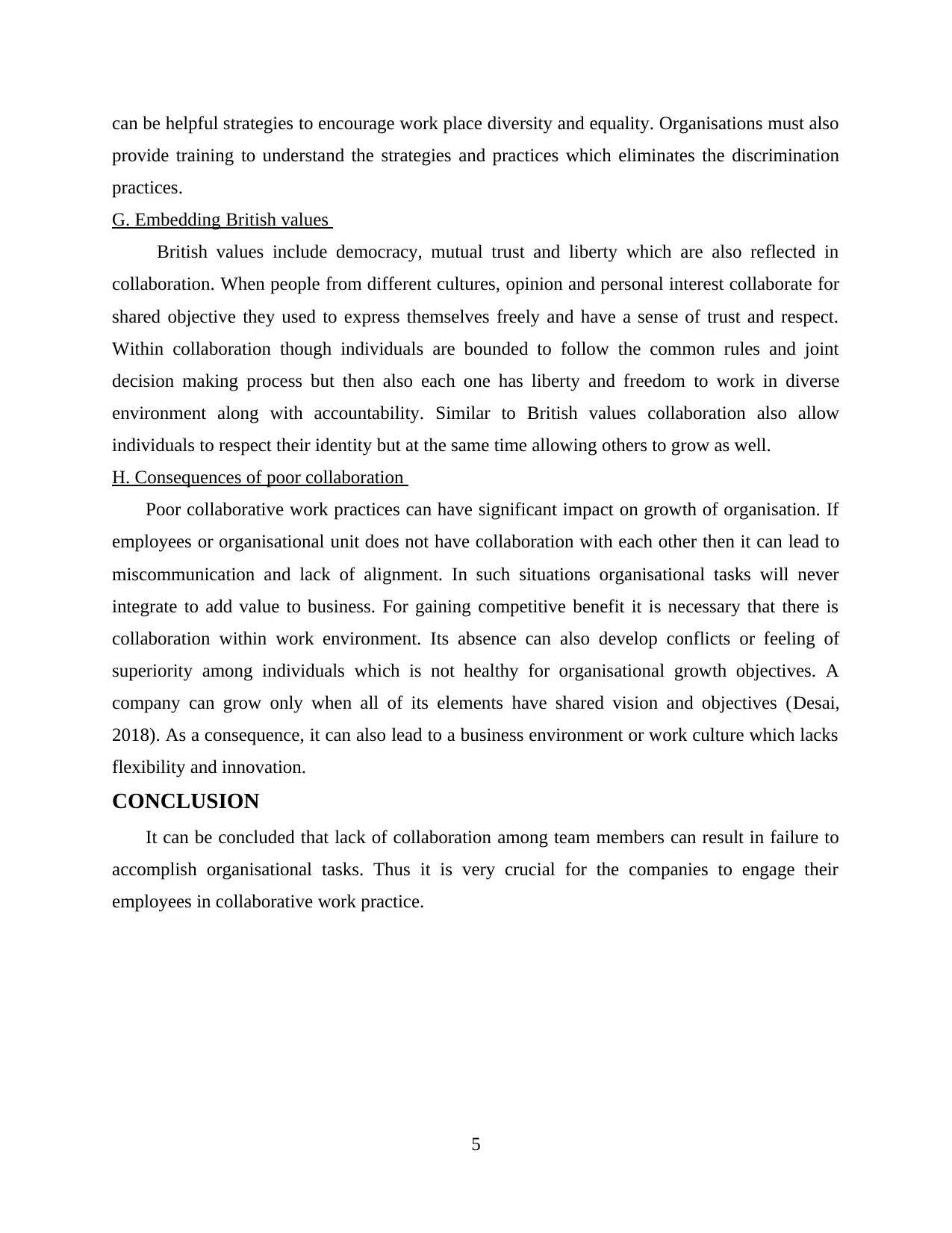
can be helpful strategies to encourage work place diversity and equality. Organisations must also
provide training to understand the strategies and practices which eliminates the discrimination
practices.
G. Embedding British values
British values include democracy, mutual trust and liberty which are also reflected in
collaboration. When people from different cultures, opinion and personal interest collaborate for
shared objective they used to express themselves freely and have a sense of trust and respect.
Within collaboration though individuals are bounded to follow the common rules and joint
decision making process but then also each one has liberty and freedom to work in diverse
environment along with accountability. Similar to British values collaboration also allow
individuals to respect their identity but at the same time allowing others to grow as well.
H. Consequences of poor collaboration
Poor collaborative work practices can have significant impact on growth of organisation. If
employees or organisational unit does not have collaboration with each other then it can lead to
miscommunication and lack of alignment. In such situations organisational tasks will never
integrate to add value to business. For gaining competitive benefit it is necessary that there is
collaboration within work environment. Its absence can also develop conflicts or feeling of
superiority among individuals which is not healthy for organisational growth objectives. A
company can grow only when all of its elements have shared vision and objectives (Desai,
2018). As a consequence, it can also lead to a business environment or work culture which lacks
flexibility and innovation.
CONCLUSION
It can be concluded that lack of collaboration among team members can result in failure to
accomplish organisational tasks. Thus it is very crucial for the companies to engage their
employees in collaborative work practice.
5
provide training to understand the strategies and practices which eliminates the discrimination
practices.
G. Embedding British values
British values include democracy, mutual trust and liberty which are also reflected in
collaboration. When people from different cultures, opinion and personal interest collaborate for
shared objective they used to express themselves freely and have a sense of trust and respect.
Within collaboration though individuals are bounded to follow the common rules and joint
decision making process but then also each one has liberty and freedom to work in diverse
environment along with accountability. Similar to British values collaboration also allow
individuals to respect their identity but at the same time allowing others to grow as well.
H. Consequences of poor collaboration
Poor collaborative work practices can have significant impact on growth of organisation. If
employees or organisational unit does not have collaboration with each other then it can lead to
miscommunication and lack of alignment. In such situations organisational tasks will never
integrate to add value to business. For gaining competitive benefit it is necessary that there is
collaboration within work environment. Its absence can also develop conflicts or feeling of
superiority among individuals which is not healthy for organisational growth objectives. A
company can grow only when all of its elements have shared vision and objectives (Desai,
2018). As a consequence, it can also lead to a business environment or work culture which lacks
flexibility and innovation.
CONCLUSION
It can be concluded that lack of collaboration among team members can result in failure to
accomplish organisational tasks. Thus it is very crucial for the companies to engage their
employees in collaborative work practice.
5
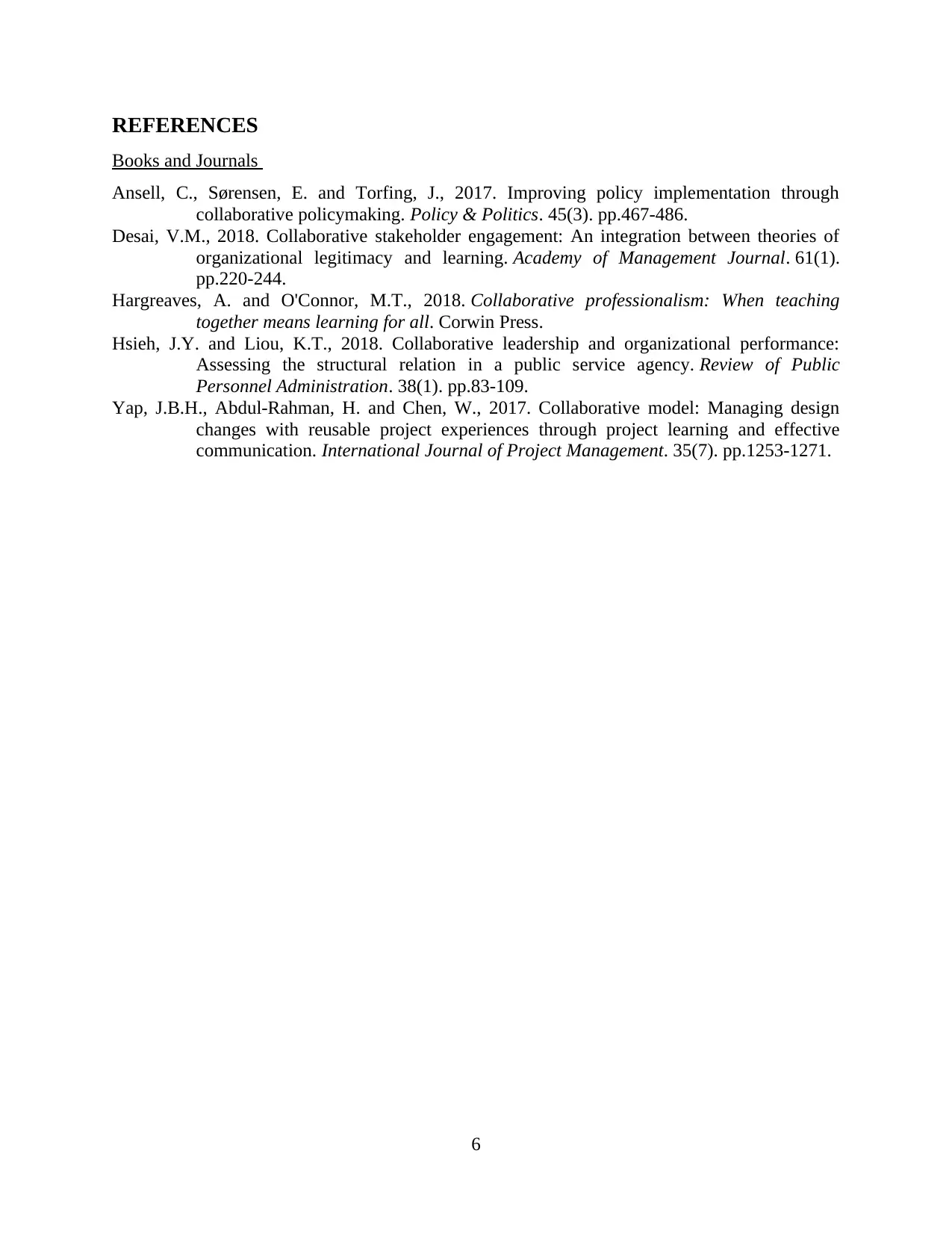
REFERENCES
Books and Journals
Ansell, C., Sørensen, E. and Torfing, J., 2017. Improving policy implementation through
collaborative policymaking. Policy & Politics. 45(3). pp.467-486.
Desai, V.M., 2018. Collaborative stakeholder engagement: An integration between theories of
organizational legitimacy and learning. Academy of Management Journal. 61(1).
pp.220-244.
Hargreaves, A. and O'Connor, M.T., 2018. Collaborative professionalism: When teaching
together means learning for all. Corwin Press.
Hsieh, J.Y. and Liou, K.T., 2018. Collaborative leadership and organizational performance:
Assessing the structural relation in a public service agency. Review of Public
Personnel Administration. 38(1). pp.83-109.
Yap, J.B.H., Abdul-Rahman, H. and Chen, W., 2017. Collaborative model: Managing design
changes with reusable project experiences through project learning and effective
communication. International Journal of Project Management. 35(7). pp.1253-1271.
6
Books and Journals
Ansell, C., Sørensen, E. and Torfing, J., 2017. Improving policy implementation through
collaborative policymaking. Policy & Politics. 45(3). pp.467-486.
Desai, V.M., 2018. Collaborative stakeholder engagement: An integration between theories of
organizational legitimacy and learning. Academy of Management Journal. 61(1).
pp.220-244.
Hargreaves, A. and O'Connor, M.T., 2018. Collaborative professionalism: When teaching
together means learning for all. Corwin Press.
Hsieh, J.Y. and Liou, K.T., 2018. Collaborative leadership and organizational performance:
Assessing the structural relation in a public service agency. Review of Public
Personnel Administration. 38(1). pp.83-109.
Yap, J.B.H., Abdul-Rahman, H. and Chen, W., 2017. Collaborative model: Managing design
changes with reusable project experiences through project learning and effective
communication. International Journal of Project Management. 35(7). pp.1253-1271.
6
⊘ This is a preview!⊘
Do you want full access?
Subscribe today to unlock all pages.

Trusted by 1+ million students worldwide
1 out of 6
Related Documents
Your All-in-One AI-Powered Toolkit for Academic Success.
+13062052269
info@desklib.com
Available 24*7 on WhatsApp / Email
![[object Object]](/_next/static/media/star-bottom.7253800d.svg)
Unlock your academic potential
Copyright © 2020–2025 A2Z Services. All Rights Reserved. Developed and managed by ZUCOL.





